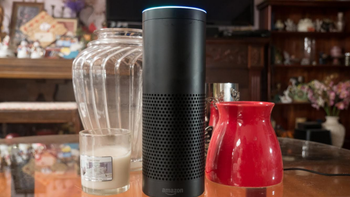Amazon is developing a new wearable that does something no device has ever done before

According to internal documents scanned by Bloomberg, Amazon is working on a voice-activated wrist-worn wearable with a special feature; it will be able to read human emotions. The device will work with a smartphone app and is equipped with microphones. The sound of the user's voice will go through software to determine what kind of emotional state he or she is in.
The project has a code name of Dylan, and the device could offer the wearer some suggestions on how best to communicate with other people depending on the emotions that he or she is feeling at the moment. This information could be used for targeted ads or to help recommend certain health products. In fact, the documents reviewed by Bloomberg call the device a health and wellness product.
Amazon had filed a patent application in 2017 for a method that uses software to determine if a person is feeling "joy, anger, sorrow, sadness, fear, disgust, boredom, stress or other emotional states." This would be done by having the software analyze his or her vocal patterns. Besides using this knowledge to target ads or recommend health products, it could be used to match the response of a virtual assistant (like Alexa) to the emotions of the user who made a request. An illustration that accompanied the patent application shows a woman with the sniffles telling Alexa that she is hungry. The virtual assistant realizes from the sniffles that she has a cold, and ask the woman if she would like a recipe for chicken soup.
A second patent filed by Amazon contains technology that will be used on the wearable, based on Bloomberg's review of the documents. This patent is for a system that will be able to differentiate between the device wearer's voice and background noise.
The Amazon unit responsible for this device developed the Fire Phone and the Echo smart speaker
It isn't known how far along Amazon is with this project and there is no guarantee that the technology will ever result in a consumer device. A beta test is in progress, although it is unknown whether the software that detects emotions is being tested, the pre-production hardware, or both. The Amazon unit working on this project is Lab126, the hardware group responsible for the Amazon Fire Phone fiasco. Launched in 2014, the handset featured a "dynamic perspective" 3D interface, the Mayday live video customer service chat and Firefly. The latter allowed a user to point the camera at a product and instantly find out where and how much it could be bought for. If the user liked the price, the product could be ordered through the phone. Eventually, Amazon essentially gave the handset away.

The Amazon Fire Phone was a flop
Lab126 did much better with another product it developed, the Echo smart speaker. The product created the smart speaker category, introduced the world to Alexa, and gave Amazon a way to get its feet inside a large number of consumers' doors. And since it was unable to build an operating system to compete with iOS or Android, Amazon depends on the popular Echo devices to make Alexa available to as many people as possible. This new device is one way to accomplish that, along with the new wireless Bluetooth earbuds that Amazon is working on. Promising to undercut Apple's AirPods on price, and best it on sound quality, the accessory should support Alexa.
Other hardware that Amazon is using to widen Alexa's distribution includes Echo Auto. This is a smart speaker for a car that attaches to the dashboard. The product pairs with a smartphone using Bluetooth is equipped with a microphone, and Amazon claims to have 1 million pre-orders. Priced at $49.99, Amazon is currently offering it for 50% off at its website.
Lastly, Amazon is said to be working on a robot that is being called a mobile version of Alexa. Code-named "Vesta," prototypes of the robot navigate throughout your home using cameras and software.













Things that are NOT allowed: